This article was medically reviewed by Sarah Gehrke, RN, MS. Sarah Gehrke is a Registered Nurse and Licensed Massage Therapist in Texas. Sarah has over 10 years of experience teaching and practicing phlebotomy and intravenous (IV) therapy using physical, psychological, and emotional support. She received her Massage Therapist License from the Amarillo Massage Therapy Institute in 2008 and a M.S. in Nursing from the University of Phoenix in 2013.
There are 21 references cited in this article, which can be found at the bottom of the page.
This article has been viewed 685,181 times.
Verrucas—commonly known as plantar warts—are warts on the soles of the feet, caused by the very contagious HPV virus.[1] This is not the same as the HPV that causes genital warts. HPV has over 180 different strains and they all prefer different body areas.[2] They are most commonly located on the ball of the foot and may or may not be painful to walk on. Verrucas can be somewhat difficult to get rid of, but there are several different things you can try. All verrucas go away on their own, with time, so don't worry if these tips don't completely work on their own. In combination, however, most people can get rid of verrucas in no time.
Steps
Handling Any Verruca Quickly
-
1Use home freezing kits to quickly remove the bulk of the verruca. Verrucas are simply warts on the bottom of your feet. About 66% of verrucas will go away within two to three years.[3] If they are painful or bothering you, however, you should consider cryotherapy, which is freezing off the wart. Freezing hardens and kills skin cells rapidly. Once they warm up the skin cracks off, removing the verruca.
- No treatment option, unfortunately, is 100% effective. However, freezing is considered the most successful option and is usually be repeated 2-3 times to fully destroy the verruca.
- Freezing at home is best for smaller warts, under 1 centimeter in size. Still, you will likely need to repeat the process several times.
- Freezing is somewhat painful, so it may not be the best option for young children.[4]
- If you are worried about the procedure or have large verrucas that seem resistant to treatment, you can get professional cryotherapy at your doctor or dermatologist's office.
-
2Use bandages and creams with salicylic acid to break down verrucas over time. Found in most over-the-counter wart removers, salicylic acid is the best way to painlessly remove a verruca. However you may need to use a concentration of up to 40% salicylic acid on some plantar warts.[5] Buy some at your local pharmacy and use according to the directions on the box.
- Your treatment make take several weeks, depending on the verruca.
- Remove the bandage and wash the verruca with soap and water once a day.
- You often get faster results if you grind down the wart with a pumice stone or nail file before applying.[6] Never share pumice stones or nail files because this may spread the infection to someone else.[7]
Advertisement -
3See a doctor if your verruca is too painful to walk on, larger than 1 inch, or unsightly. All verrucas will go away on their own with time. But if the wart is getting in the way of your daily life, a doctor can help expedite the process through a variety of treatments. Seeing the doctor is rarely medically necessary, but it will help you get treatment faster.[8]
- You should also see a doctor if you have warts that appear in clusters. These are known as mosaic warts and they are more difficult to treat than solitary warts.[9]
-
4Avoid verrucas by wearing shoes in communal showers and bringing your own towels and washcloths to the pool and gym. Verrucas are caused by a virus found in moist, warm environments. It enters your skin through any small cuts or openings in your foot, and thus the verruca is born. By protecting your feet in warm, wet, communal environments you can be sure to avoid most verrucas.
- Keep in mind that the virus can lay dormant. This means that while you may not have any symptoms and HPV may not show up on tests, you may still technically have the virus.[10]
Freezing Verrucas Yourself
-
1Take an over-the-counter pain reliever if you are worried about the pain. 30 minutes or so before applying treatment, take 1-2 regular strength pain relief pills. Advil or Ibuprofen are perfectly acceptable anti-inflammatory drugs that will decrease the pain of the procedure. While freezing off a wart is not an unbearable pain, you can make the procedure as pleasant as possible.[11]
-
2Apply the freezing agent as directed. You can purchase a home cryotherapy kit, usually sold for under $20, at most drug stores. Follow the instructions on your bottle if you are performing at home. Usually, there is a small, tipped prod or swab that must be chilled. You then touch this to the verruca for 2-3 seconds. While most home cryotherapy kits work the same way, be sure to read the specific instructions on your kit in order to get the best results.
- You will feel a sharp, pinch-like pain for 3 seconds or so, but after that the pain should fade. After 10-15 minutes you will likely feel nothing but light numbness.
- If you have a low pain tolerance, sit down to perform the procedure. While fainting is uncommon, you want to make sure you don't hit anything if you feel woozy.
-
3Wrap the frozen-over area lightly with a bandage. After freezing, a scab will form over the verruca. You may even have a small blister develop. Use sterile gauze to cover up the verruca, and make sure that it is not draining or bleeding.
- If you get a blister, and it breaks, carefully wipe up and contain the fluid. It may contain the wart virus.[12] Then, clean the area with mild soap and water. Dry the area and cover it with a clean, non-stick bandage.[13]
- While you can continue normal activity after cryotherapy, avoid swimming and using a hot tub. The water may contain bacteria that can cause infections in the wart. For the first 24 hours after treatment, you should avoid soaking the area with water in any way, such as by washing dishes.[14]
-
4Refreeze the wart 2-3 weeks later if it persists. Only small warts can be removed with just one freezing. More often than not you'll need several treatments. Be sure to keep the scab and any blisters properly cleaned between treatments to avoid infection. However, it is best to leave any scabs or blisters uncovered.[15]
- See a doctor if you have bleeding, discharge, numbness lasting more than 2-3 days, or swelling consistent with an infection.[16]
Removing Verrucas at Home
-
1Couple freezing with home remedies for the best response. While freezing is the quickest, most effective method for removing warts, it rarely destroys the wart completely on the first try. Freezing can remove the bulk of the wart, making patches, salicylic acid, or other methods more effective. Using a combination of freezing and the following home remedies to best fight the verruca.
-
2Weaken the wart with warm water and light filing. You can make your wart treatments much more effective if you take the time to physically weaken it. Before treating the wart, use a pumice stone or a file to gently sand down the wart, removing the top layer of skin so that the medicine is more effective. You should also soak your foot in warm water before applying gels and creams, softening the skin and making it more receptive.
- Make sure you dry your foot and wipe away any dead skin before applying any treatments.[17]
-
3Use salicylic acid gels, creams, and patches. Salicylic acid is the main ingredient in most over-the-counter wart treatments. You can find it in gels and patches, making it a convenient, effective way to treat your verrucas over time. Generally treatment occurs slowly, often taking 12 weeks or longer to completely destroy the verrucas. Because of the amount of time it takes, many people use salicylic acid in conjunction with freezing or other removal methods.
- Salicylic acid damages healthy skin as well as unhealthy, but you can protect the skin around your verrucas with a light coating of petroleum jelly.
- Keep the wart covered after applying the salicylic acid so that the medicine stays close to the skin.[18]
-
4Try duct tape. While there is little hard evidence about the effectiveness of duct tape treatment, many people swear by its effectiveness. Apply a piece of duct tape tightly over the verruca and left there for six days.When the six days come to an end, remove the tape and soak the verruca for 5 minutes in warm water. Duct tape supposedly works by containing the virus near the skin, aggravating it while causing your immune system to focus on the wart and destroy it.
- If the tape falls apply a fresh piece of tape immediately.
- This may need to be repeated, or used in conjunction with other methods, so don't be alarmed if you still have a wart, or if it returns, when treatment is finished.
-
5Pierce the verruca, then disinfect and cover it. This method simply speeds up your natural immune response to the wart, bringing white blood cells to the area that was cut. While this method is not strictly recommended, as it can be incredibly painful, it does have its merits. It is completely natural, costs nothing, and helps your body fight the infection on its own. If you decide to pierce it:
- Sterilize the needle ahead of time by holding it over an open flame for 5-10 seconds.
- Clean the wart with soap and water. Soak it for 5 minutes in warm water to loosen the skin.
- Piece the wart with a quick, shallow movement. You only need to break the skin. This will be painful.
- Clean the wart, cover with antibacterial ointment, and bandage it up for 1-2 weeks.[19]
-
6Give verrucas time to disappear on their own. All verrucas will clear up by themselves within a year or two, so if the verruca is not causing you any pain, you should consider letting it run its course. This is the easiest, best way to get rid of your warts, as your immune system does all the work.
- However, verrucas will rarely clear up on their own in people with weakened immune systems (such as people with HIV), so it is recommended that they seek treatment.
- Avoid high-heeled shoes, or anything that puts a lot of your weight onto the verruca, to ease the pain. Thicker socks and comfortable shoes will all help.
- You can buy moleskin and craft a donut-shaped pad, leaving the verruca in the middle. This padding can prevent you from painfully stepping on the wart.
Removing Verrucas with a Doctor
-
1Have the verruca pared down. In some cases, verrucas can be pared or rubbed down by a podiatrist or a chiropodist. This often happens in conjunction with other therapies, as it makes it easier for the medicine to get to the root of the wart and destroy it.
- This will not completely remove the verruca, but it will decrease its size and hopefully make it less painful.
-
2Have the verruca professionally frozen off. It is possible to remove verrucas at the doctor's office using liquid nitrogen. This procedure is known as cryotherapy, and is a more intense version of home cryotherapy kits.
- The liquid nitrogen is sprayed on the verruca, destroying the skin cells through freezing. A blister will form following the procedure, which will scab over and fall off within a number of days, taking the verruca with it.[20]
- For very large verrucas, the procedure may need to be repeated several times before the verruca is completely removed.
- Cryotherapy can be quite painful, so it is not recommended for young children.
-
3Get a prescription for chemical treatments. In some instances, your doctor will prescribe a chemical treatment in which a corrosive substance is dabbed directly onto the verruca to kill the skill cells. Some prescription treatments include:
- Retinoid cream (Avita, Retin-A).
- Cantharidin (Cantharone, Cantharone Plus). This medicine causes the skin under the wart to blister, lifting the wart off the skin. This medicine is applied to the wart at your doctor's office.
- Immunotherapy medicines to fight the HPV virus.
- Bleomycin injections, though these are very painful and rarely used anymore.[21]
-
4Opt for laser or surgical removal for serious verrucas. Used only in the most extreme cases, this will get rid of the wart quickly and permanently. It may, however, be expensive and your foot will be painful to walk on, making this one of the least attractive options to get rid of your wart.
Preventing the Spread of Verrucas
-
1Cover your verruca at the swimming pool. Verrucas are most commonly passed from person to person at the swimming pool, therefore it is important to cover your verruca with a waterproof plaster when you go swimming. Alternatively, you can buy special swim socks at the pharmacy.
- You can cover the verruca in nail polish varnish, which creates a seal that prevents you from passing the virus on to other people.[22] However, keep in mind that this is not a scientifically proven method.
-
2Don't share towels, socks or shoes. Verrucas can spread through the sharing of towels, socks, and shoes, so if you have a verruca, do not share these items with others. At the gym or local pool, you should bring and use your own equipment.
-
3Wear flip-flops in communal showers. Similarly to swimming pools, verrucas can easily be passed from person to person in communal showers. You should wear flip-flops when using public showers.[23]
-
4Never touch other people's warts, or touch yours without washing your hands. Some strains of the HPV virus are more contagious than others, so you should keep the verruca covered and avoid touching other people's warts.[24]
-
5Use the sterilizing wipes at the gym. The gym is the most common place to get verrucas for adults, but they can be easily prevented using the wipes found near the equipment. Be sure to wipe down anything you use after you're done, and consider getting some lifting gloves if you are worried about spreading verrucas.[25]
Expert Q&A
Did you know you can get premium answers for this article?
Unlock premium answers by supporting wikiHow
-
QuestionCan you kill verrucas with Vaseline?
 Sarah Gehrke, RN, MSSarah Gehrke is a Registered Nurse and Licensed Massage Therapist in Texas. Sarah has over 10 years of experience teaching and practicing phlebotomy and intravenous (IV) therapy using physical, psychological, and emotional support. She received her Massage Therapist License from the Amarillo Massage Therapy Institute in 2008 and a M.S. in Nursing from the University of Phoenix in 2013.
Sarah Gehrke, RN, MSSarah Gehrke is a Registered Nurse and Licensed Massage Therapist in Texas. Sarah has over 10 years of experience teaching and practicing phlebotomy and intravenous (IV) therapy using physical, psychological, and emotional support. She received her Massage Therapist License from the Amarillo Massage Therapy Institute in 2008 and a M.S. in Nursing from the University of Phoenix in 2013.
Registered Nurse
-
QuestionWhat will happen if I don't treat a verruca and just leave it?
 Sarah Gehrke, RN, MSSarah Gehrke is a Registered Nurse and Licensed Massage Therapist in Texas. Sarah has over 10 years of experience teaching and practicing phlebotomy and intravenous (IV) therapy using physical, psychological, and emotional support. She received her Massage Therapist License from the Amarillo Massage Therapy Institute in 2008 and a M.S. in Nursing from the University of Phoenix in 2013.
Sarah Gehrke, RN, MSSarah Gehrke is a Registered Nurse and Licensed Massage Therapist in Texas. Sarah has over 10 years of experience teaching and practicing phlebotomy and intravenous (IV) therapy using physical, psychological, and emotional support. She received her Massage Therapist License from the Amarillo Massage Therapy Institute in 2008 and a M.S. in Nursing from the University of Phoenix in 2013.
Registered Nurse Leaving the verruca (plantar wart), or any other wart, to be cleared by your immune system is perfectly fine. You would want to seek treatment if the verruca is painful or affecting your daily activities. Leaving the verruca to clear on its own will take patience on your part, however. Some verrucas may stick around for up to two years.
Leaving the verruca (plantar wart), or any other wart, to be cleared by your immune system is perfectly fine. You would want to seek treatment if the verruca is painful or affecting your daily activities. Leaving the verruca to clear on its own will take patience on your part, however. Some verrucas may stick around for up to two years.
References
- ↑ https://medlineplus.gov/warts.html
- ↑ https://medlineplus.gov/ency/article/000885.htm
- ↑ http://healthcenter.indiana.edu/answers/warts.shtml
- ↑ http://www.nhs.uk/Conditions/Warts/Pages/Treatment.aspx
- ↑ http://www.nationwidechildrens.org/dermatology-wart-treatment
- ↑ http://www.nhs.uk/conditions/warts/pages/introduction.aspx
- ↑ http://www.nationwidechildrens.org/dermatology-wart-treatment
- ↑ http://www.webmd.com/skin-problems-and-treatments/cryotherapy-for-warts
- ↑ https://www.foothealthfacts.org/conditions/plantar-wart-(verruca-plantaris)
- ↑ http://ahcchpv.com/hpv-dormant-period/
- ↑ http://www.drugs.com/cg/cryotherapy-wart-removal-aftercare-instructions.html
- ↑ http://www.webmd.com/skin-problems-and-treatments/cryotherapy-for-warts
- ↑ http://www.skinsight.com/skin-conditions/first-aid/first-aid-blisters?Imiw9cApl
- ↑ https://uhs.berkeley.edu/sites/default/files/liquidnitrogentreatment.pdf
- ↑ https://uhs.berkeley.edu/sites/default/files/liquidnitrogentreatment.pdf
- ↑ http://familydoctor.org/familydoctor/en/diseases-conditions/warts/treatment.html
- ↑ http://www.nhs.uk/Conditions/Warts/Pages/Treatment.aspx
- ↑ http://familydoctor.org/familydoctor/en/diseases-conditions/warts/treatment.html
- ↑ http://www.dailymail.co.uk/news/article-2083579/Time-ONLY-cure-verruca.html
- ↑ http://dermnetnz.org/viral/viral-warts.html
- ↑ http://www.webmd.com/skin-problems-and-treatments/warts-treatments-home-remedies
- ↑ http://www.dailymail.co.uk/news/article-2083579/Time-ONLY-cure-verruca.html
- ↑ https://patient.info/skin-conditions/warts-and-verrucas-leaflet
- ↑ http://www.hse.ie/eng/health/az/V/Verrucas-and-warts/Preventing-warts-and-verrucas.html
- ↑ http://www.news-medical.net/health/Prevention-of-verrucas.aspx
- ↑ http://www.webmd.com/skin-problems-and-treatments/cryotherapy-for-warts
About This Article
One easy way to remove verrucas, also known as plantar warts, is to use a home freezing kit. This process is a little painful so if you’re worried about it hurting, take an over-the-counter pain reliever, like Advil or Ibuprofen, 30 minutes before you apply the treatment. A home freezing kit usually involves chilling a small swab and holding it against your verruca for 2-3 seconds, but make sure you follow the instructions on the label. Alternatively, you can buy a cream or bandage with salicylic acid, which is painless and breaks the verruca down over time. If your verruca is larger than an inch or is too painful to walk on, visit your doctor for treatment. For more tips from our Medical co-author, including how to let verrucas heal on their own, read on!

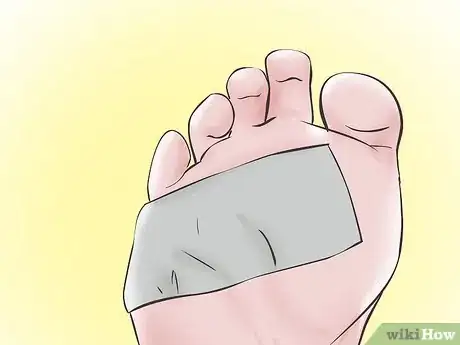
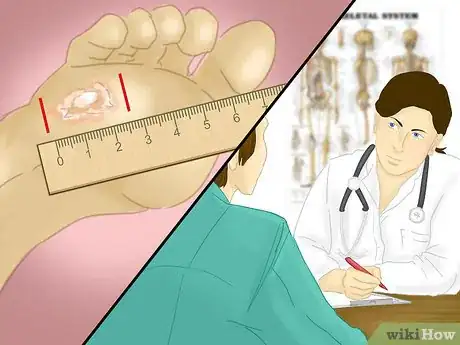
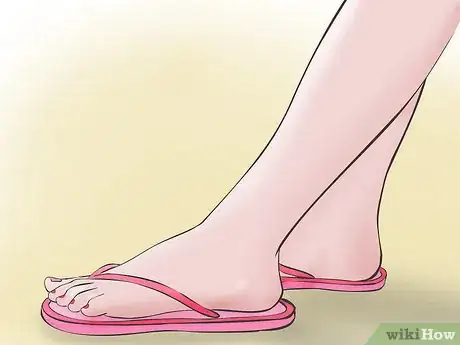
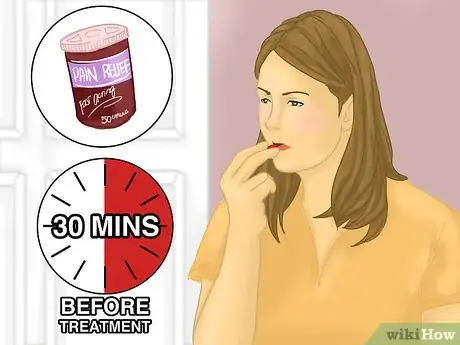


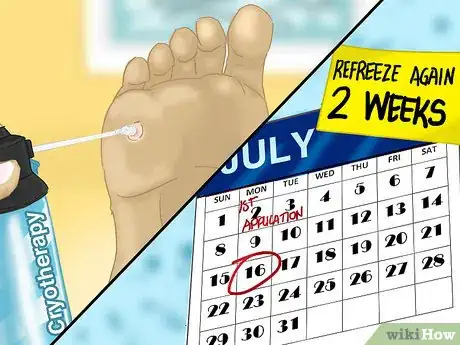
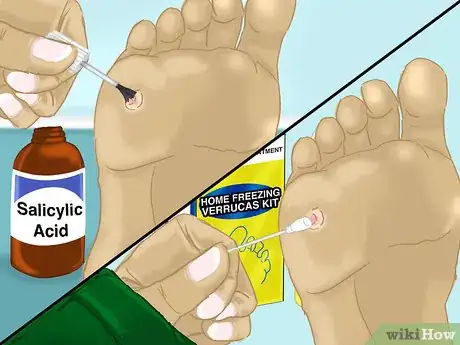
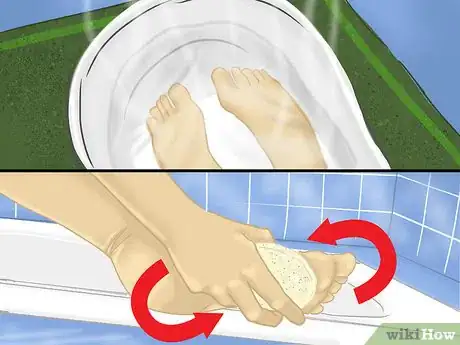

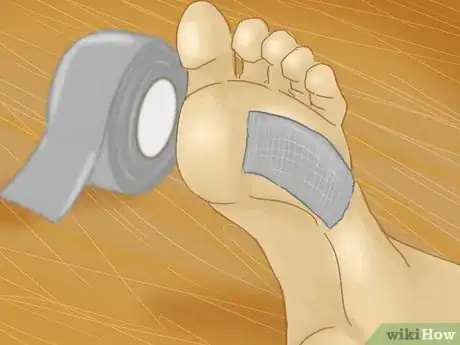
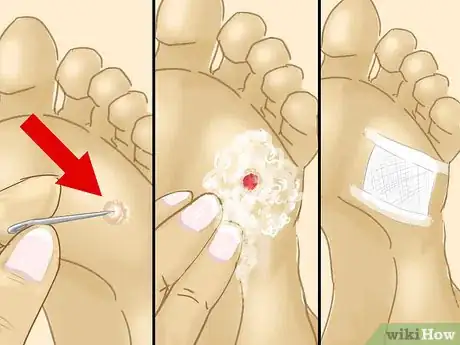

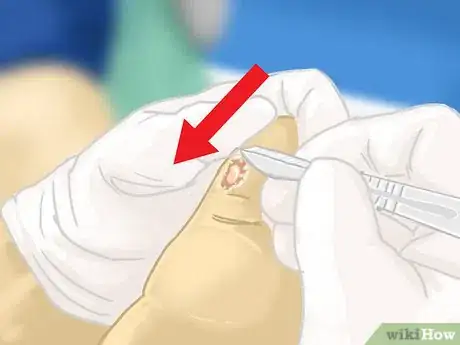
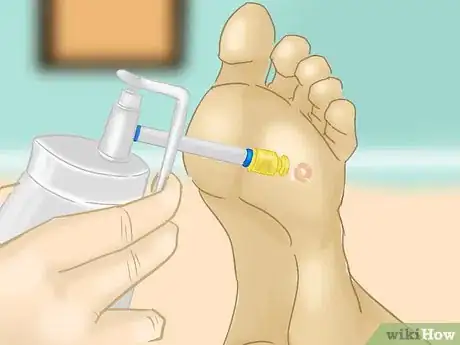
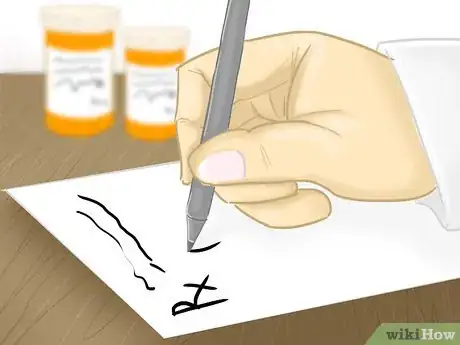
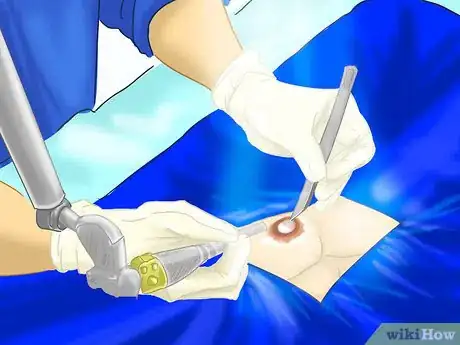
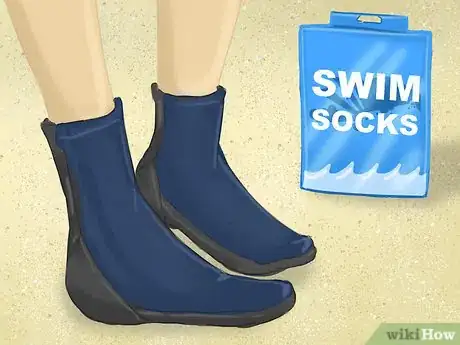
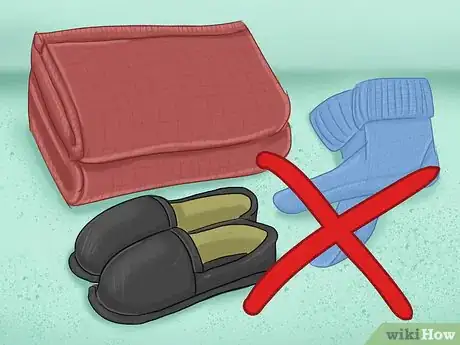
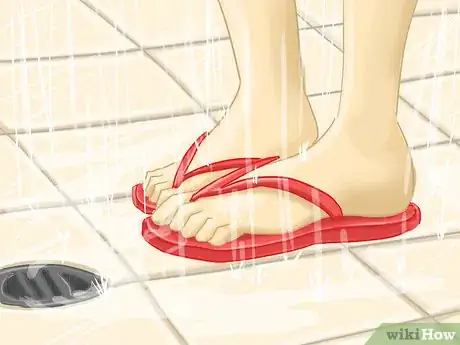
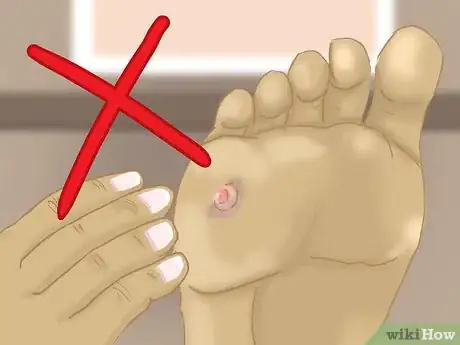
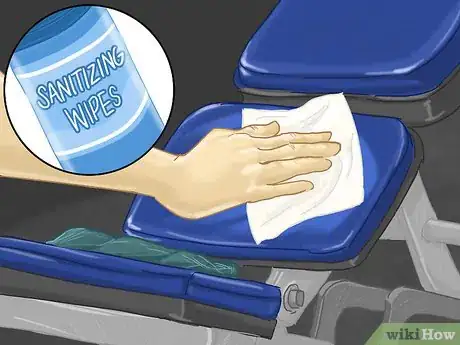
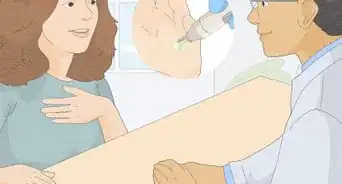
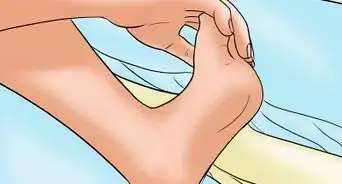
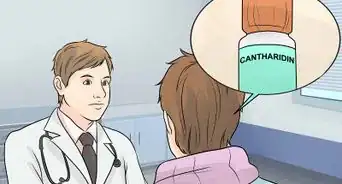
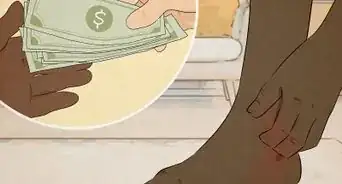
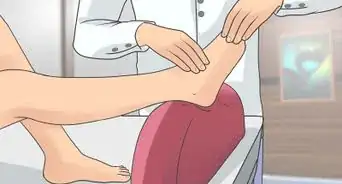

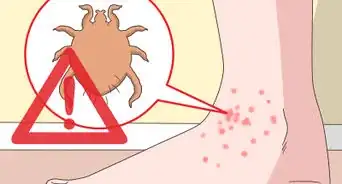


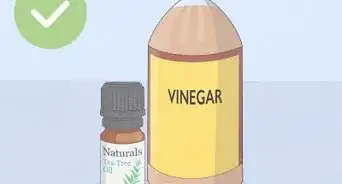
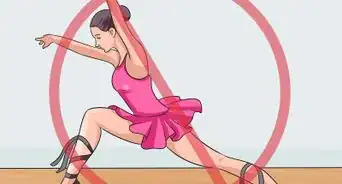


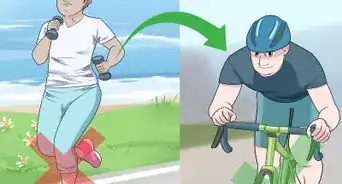










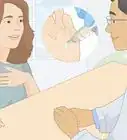
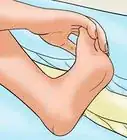
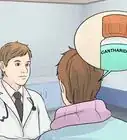




































Medical Disclaimer
The content of this article is not intended to be a substitute for professional medical advice, examination, diagnosis, or treatment. You should always contact your doctor or other qualified healthcare professional before starting, changing, or stopping any kind of health treatment.
Read More...